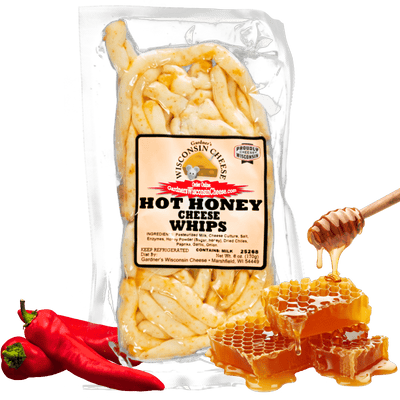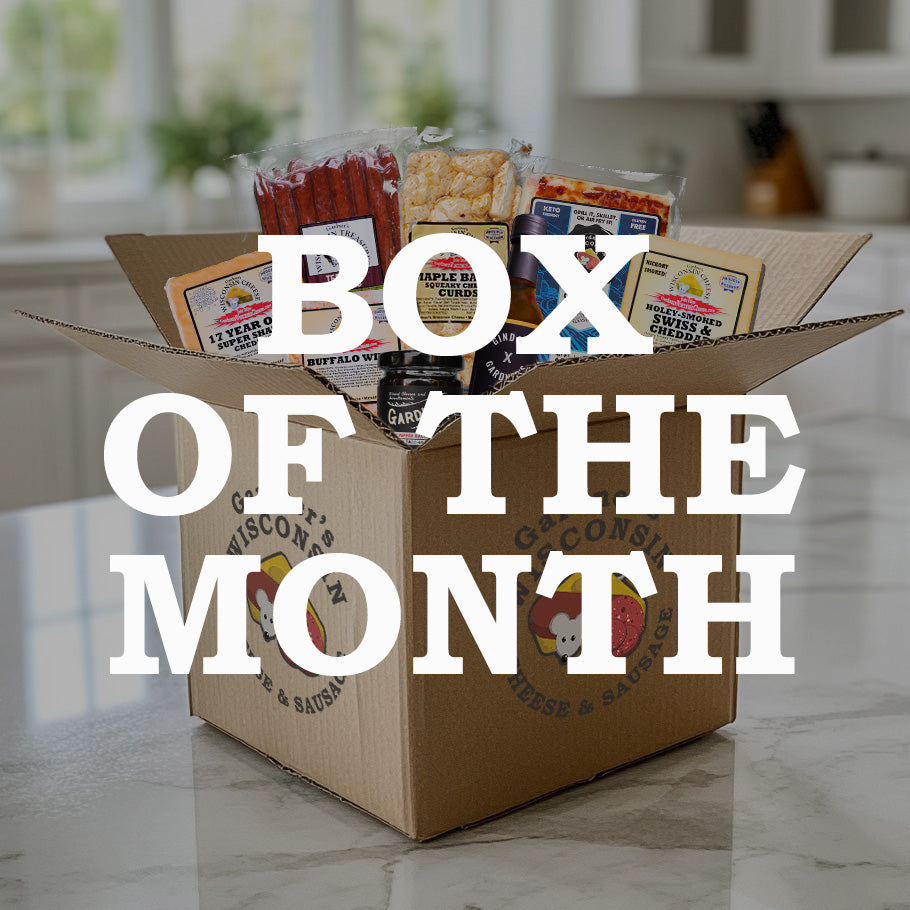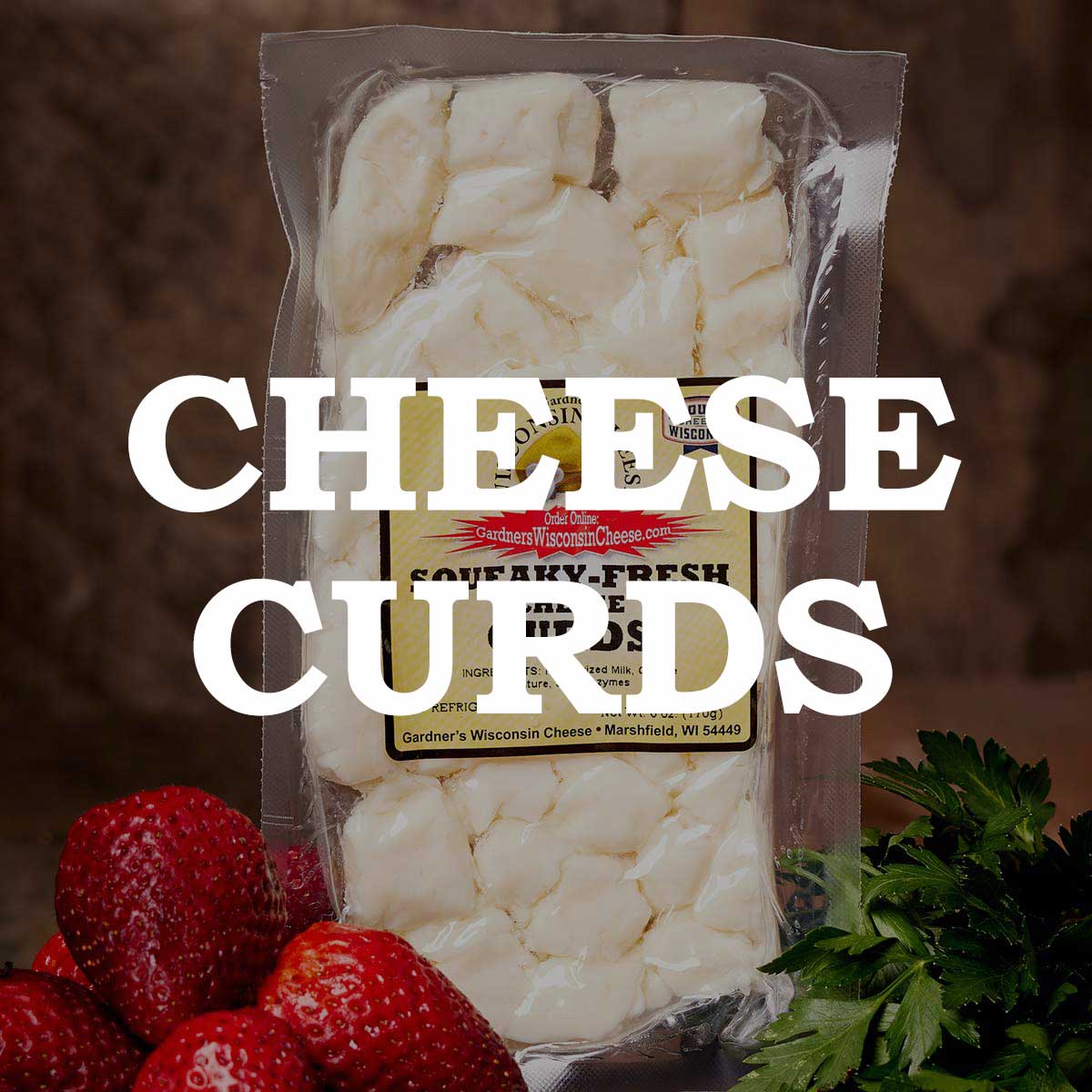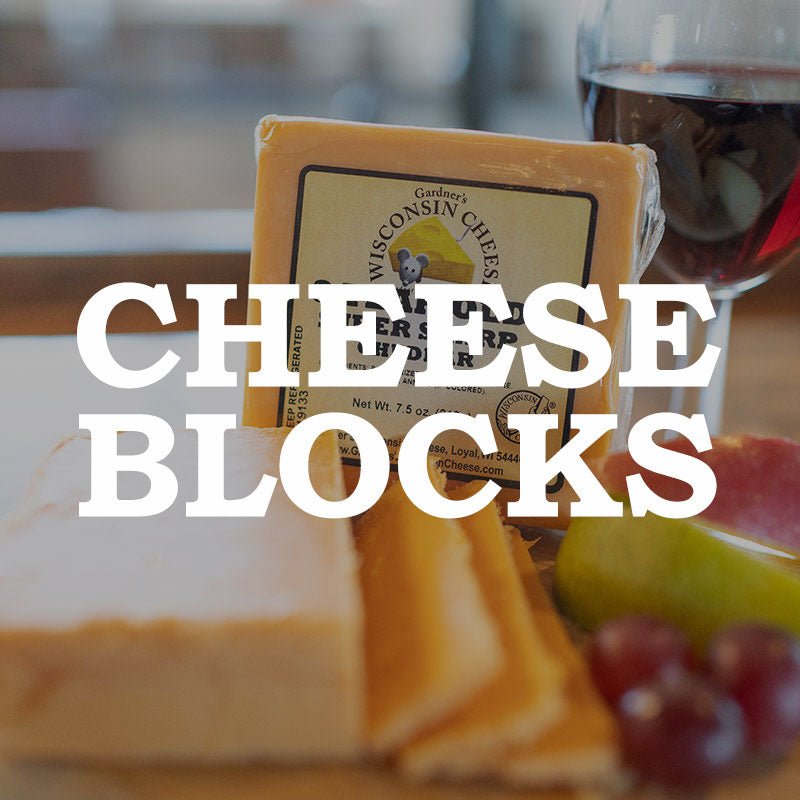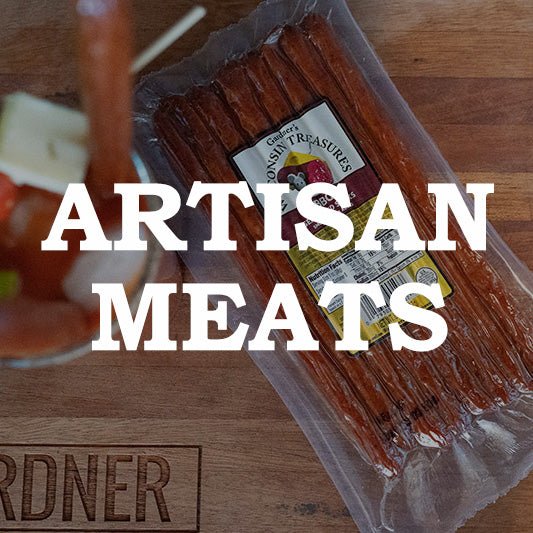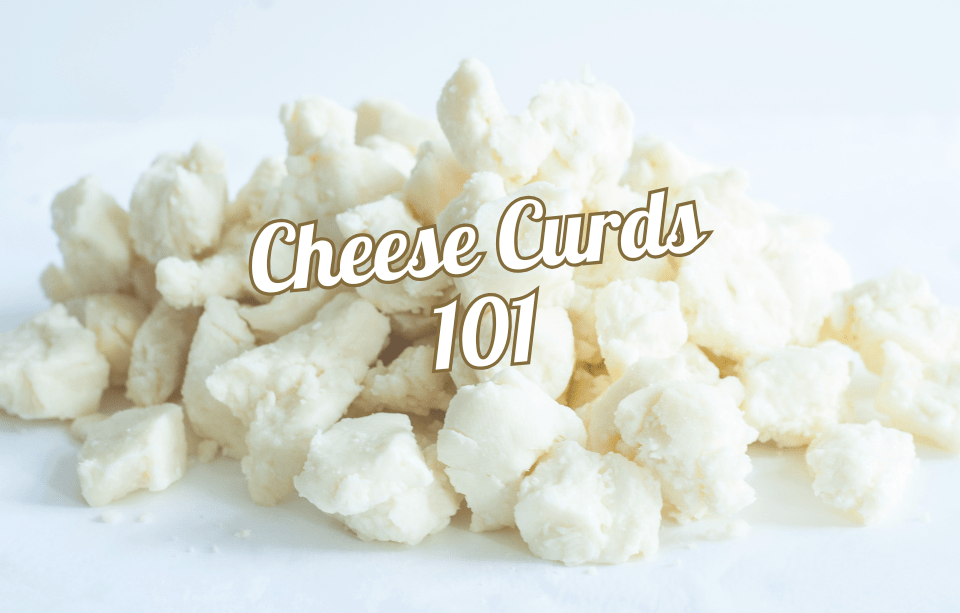
· By Daylon Gardner
Cheese Curds 101: What They Are, How They’re Made, and Best Ways to Enjoy Them
If you’ve ever bitten into a cheese curd and heard that signature squeak, you know they’re something special. If not, get ready, because we’re diving curd-first into what they are, how they’re made, and why Wisconsin loves them. From fresh curds to fried favorites, flavor twists to pairing tips, this guide covers everything you need to enjoy curds “whey” better. And for a deep dive into curd history, check out our article “The Surprising History of Cheese Curds”.
Let’s get to the curd of the matter (because yes, it’s kind of a big dill).
What Are Cheese Curds?
Cheese curds aren’t a special type of cheese, they’re a special stage. Think of them as young cheddar: fresh, mild, and delightfully squeaky. These bite-sized nuggets form during the cheesemaking process, before the curds are pressed and aged into blocks. In Wisconsin, curds are often sold the same day they’re made, sometimes even at room temperature, to highlight their just-made freshness. They’re the bouncy, cheerful toddlers of the cheese world, and many fans love them just the way they are.
So, in a nutshell: Cheese curds are the tender, young offspring of cheddar. They’re mild, tangy, and squeakily fresh. They’re the curdy little building blocks from which other cheeses grow up… but many of us love them just the way they are!
How Are They Made?
To understand how cheese curds come to be, let’s take a quick trip through a cheese factory. It all starts with high-quality milk (cow’s milk for the classic Wisconsin curd). The milk is pasteurized and mixed with special cultures and rennet, which causes it to coagulate (i.e. separate into curds and whey, picture Miss Muffet’s snack). Once the mixture resembles a custard, the cheesemaker cuts it into tiny pieces, releasing the liquid whey. Those pieces begin shrinking into the curds we’re after.
For cheddar and related cheeses, there’s an extra step known as cheddaring. The fresh curds get gently heated and stirred, then piled up and pressed into slabs that are flipped and stacked repeatedly to squeeze out more whey. This process knits the curds together. The cheesemaker then runs the slabs through a mill, chopping them into the familiar random-sized chunks: voilà, cheddar cheese curds! At this point, the curds are fresh, young cheddar ready to eat. (Fun fact: It takes about 10 pounds of milk to make just 1 pound of cheese curds. No wonder they’re so rich and satisfying!)
If the cheesemaker were making a wheel of cheddar instead, those curds would be pressed into a mold and aged for months or years. But with curds, we skip the aging. They go from vat to bag to your mouth in short order. Because they aren’t aged or heavily salted, curds retain a mild, dairy-fresh flavor and a high moisture content, which is why they squeak and also why they spoil faster than aged cheese. It’s quick cheesemaking and quick snacking, a win-win for impatient cheese lovers.
Why Are They Such a Big Deal in Wisconsin?
Wisconsin isn’t called “America’s Dairyland” for nothing. The state has been making cheese since before it became a state, and cheese curds are a way of life here, found everywhere from brewery taprooms to gas stations. Locals proudly call themselves “cheeseheads,” and yes, those foam wedge hats are very real.
What makes Wisconsin curds so special? Freshness. Curds are best within hours of being made, when they still squeak. Thanks to the state’s many dairies, locals often snack on curds still warm from that morning’s cheesemake. Wisconsin even allows same-day curds to be sold unrefrigerated to preserve peak flavor. Now that’s dedication.
Fried cheese curds are a staple on menus across the state, and there’s even a National Cheese Curd Day on October 15. As a family-owned Wisconsin company, we at Gardner’s proudly share the joy of real, fresh curds, because once you taste one, you’ll understand the hype.
Plain vs. Flavored Cheese Curds
Cheese curds come in two tasty types: plain and flavored. Classic white or orange cheddar curds are loved for their mild, milky flavor and squeaky bite. But cheesemakers have added fun twists: today, you’ll find curds seasoned with everything from garlic and dill to Cajun spice or habanero.
If you’re a purist, raw curds are perfect as-is. But for a flavor adventure, try our Garlic & Dill curds for a zesty punch, or the Maple Bacon curds for sweet-salty perfection (seriously, they taste like Sunday brunch and game day rolled into one).
Flavored or not, curds are still young cheddar at heart, just extra snackable. But be warned: once you open a bag, they tend to mysteriously vanish.
Storage and Freshness Tips (aka Keeping the Squeak)
Cheese curds are best enjoyed fresh, but what if you can’t eat that whole bag in one go (hey, it happens)? Here are some tips to make the most of your curds’ freshness:
-
Eat ASAP for max squeak: That squeaky bite is a sign of freshness—caused by proteins rubbing against your teeth. Curds usually lose their squeak after 4-6 days, so enjoy them within a day or two of delivery for the best experience.
-
Room temp Day 1, fridge after: Once delivered, your curds can stay at room temp for 24 hours (they’ll squeak the most!). After that, refrigerate them. They’ll still taste great, just with a firmer texture and less squeak.
-
Reheat to revive: A quick 5–10 second microwave zap can bring back some squeak in older curds. Just don’t overdo it unless you’re aiming for a melty cheese puddle.
-
Freeze if needed: Got extra bags? Freeze them. They won’t squeak as much after thawing but they will work perfectly in cooked dishes like omelets or poutine.
In short, squeaky = fresh. To keep that fresh flavor as long as possible, keep curds cool once they’ve passed their first day of glory on delivery day. But honestly, around here we rarely have leftovers long enough to worry about it!
How to Prepare Them: Raw, Fried, and Beyond
One of the best things about cheese curds is how versatile they are. You can enjoy them straight out of the bag, or incorporate them into all sorts of recipes. Here are some of the best ways to enjoy cheese curds:
-
Enjoy Them Fresh and Raw: No prep needed, just open the bag and snack away, especially while they’re still squeaky. They’re perfect solo or piled onto a cheese board with crackers, meats, and fruit.
-
Deep-Fried Cheese Curds: The most iconic way to enjoy curds: battered, golden, and gooey inside. Found everywhere in Wisconsin, they’re often served with ranch or marinara. Want to try it at home? Freeze the curds first so they don’t melt too fast when frying.
-
Air-Fried Cheese Curds: Craving crunch without the oil? Air frying gives curds a crispy outside and melty center, no deep fryer needed. Try our Air Fryer Cheese Curds recipe for an easy, mess-free snack. Bonus: they’re great with your favorite dip!
-
Tossed into Dishes: Cheese curds aren’t just for snacking, they’re great in dishes like poutine, salads, casseroles, mac & cheese, or scrambled eggs. Use them anywhere you’d add mozzarella or cheddar for melty, cheesy bites and fun texture.
No matter how you prepare them, one thing is constant: cheese curds make everything better. They’re a chef’s secret weapon for adding indulgent, cheesy joy to just about any food.
(Need more inspiration? We have plenty of cheesy recipes on our blog, from classic deep-fried curds to creative uses in appetizers. The possibilities are endless when you’re working with cheese this fun!)
Pairing Suggestions: Curds, Drinks & Other Eats
Cheese curds are friendly little guys. They get along with all sorts of beverages and accompaniments. Here are a few pairing ideas to take your curd enjoyment to the next level:

-
Adult Beverages: You can’t go wrong pairing cheese curds with a cold beer. A light pilsner or crisp lager is a classic match, while a hoppy pale ale cuts through the richness nicely. Not into beer? Try a hard cider. Its fruity sweetness pairs perfectly with mild, creamy curds (especially our maple bacon ones: chef’s kiss). For something stronger, curds make a great Bloody Mary garnish (a Wisconsin staple). And yes, wine works too: a semi-dry Riesling or light Pinot Noir complements curds much like a young cheddar. Bottom line? Trust your taste buds. Curds play well with just about anything.

-
Dips & Sauces: When serving fried or air-fried curds, be sure to put out some dips. Ranch dressing is a perennial favorite (there’s a reason “cheese curds and ranch” is a common combo in the Midwest). Marinara sauce is another winner. It turns your curds into bite-size mozzarella-stick cousins. Fancy something sweet and spicy? Try a hot honey or a sweet chili sauce drizzle over fried curds for a modern twist. Even plain yellow mustard or BBQ sauce can find a happy partnership with a cheese curd. The curds’ mild flavor means they love a little extra zing from a dip.

-
Charcuterie & Snacks: Fresh (non-fried) curds are a fabulous addition to your snack plates. Next time you assemble a charcuterie board, include a pile of curds along with the aged cheeses. They provide a different texture and that fun squeak, which is a great conversation starter. Plus, curds pair beautifully with cured meats like summer sausage (a Wisconsin fave), salami, and prosciutto. The salty, savory notes of the meat accentuate the mild creaminess of the curd. Add some crackers and pickles (or pickled veggies) to the board, and you’ve got yourself a perfect balance: tangy, meaty, creamy, crunchy. Another idea: serve curds with apple slices or grapes. The fresh fruit’s sweetness and acidity cut through the richness of the cheese, making each bite more refreshing.
In short, treat cheese curds as you would any good young cheddar or mozzarella: pair them with drinks that cleanse the palate (beer, cider, light wines) and foods that add either complementary creaminess or contrasting crunch/acid. There are no strict rules; the only requirement is that you enjoy every last bite.
(Psst... If you need specific pairing ideas for a flavored curd: the Maple Bacon curds are insanely good with a Bloody Mary or a pint of lager, and the Garlic Dill curds sing when paired with a crisp pilsner or a cucumber-infused cocktail. But honestly, you do you. There’s no wrong way to pair a curd!)
Where to Buy Authentic Cheese Curds
Craving cheese curds yet? We’ve got you covered. You can browse our cheese curds collection at Gardner’s to have fresh curds shipped straight from Wisconsin to your door. We cold-pack every order for max squeak, with options from classic plain to small-batch flavors like Garlic & Dill and Maple Bacon.
In Wisconsin? Lucky you. Fresh curds are everywhere! Look for a “Made Today” label for peak squeak. Outside the state, check local cheese shops or farmers markets… or just let us do the shipping. However you get them, we hope you enjoy the cheesy, squeaky joy of real Wisconsin curds. In the immortal words of absolutely no one: “Keep calm and curd on.”
Happy snacking, and welcome to the curd club!





